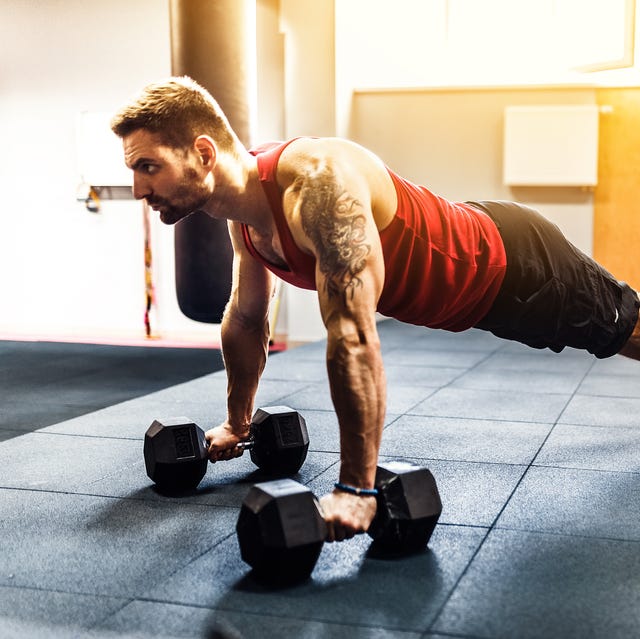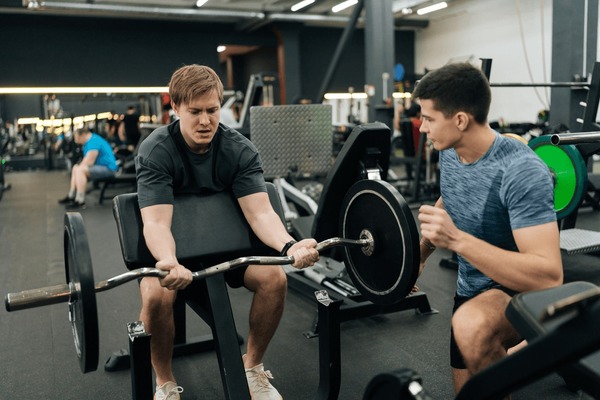Introduction: Why Weight Training is Your Key to a Better Lifestyle
The world of weight training (lifting weights) may seem complex and intimidating at first, especially when you see professional athletes lifting enormous weights in the gym. You might feel hesitant and anxious about injury or not knowing where to start. But the truth is, weight training is not exclusive to professional athletes; it is a powerful and accessible tool for everyone, and it is your true key to unlocking new levels of health and physical fitness that go beyond just building muscle.
The decision to start resistance training is a long-term investment in your physical and mental health. This article is your comprehensive and practical guide that will take you step-by-step, from hesitation to confidence, to begin your journey into the world of strength and fitness safely and effectively. We will cover everything you need to know: from understanding the basics and benefits, to safe starting steps, to designing your first training program and the nutrition that supports it.
Section One: Understanding the Basics and Benefits
What is Weight Training?
Weight training, or more broadly known as resistance training, is any form of exercise that causes your muscles to contract against an external resistance. This resistance stimulates the muscles to adapt and grow, leading to increased strength and endurance.
Resistance can come from multiple sources, making it a flexible system suitable for everyone:
Free Weights: Such as Dumbbells, Barbells, and Kettlebells. These require greater effort for balance, engaging additional stabilizing muscles. Machines: Such as cable machines and press machines. These machines provide a fixed path of motion, making them an excellent option for beginners to learn the movement safely. Bodyweight: Such as Push-ups, Squats, and Planks. These exercises require no equipment and provide a strong foundation for starting.
The Amazing Benefits of Weight Training
The benefits of weight training extend far beyond aesthetic appearance. They affect your health both internally and externally:
#### Building Muscle and Increasing Strength When you lift weights, you cause microscopic tears in the muscle fibers. During rest and recovery, the body repairs these fibers, not just returning them to their original state, but making them stronger and larger in preparation for the next challenge. This is the mechanism of muscle growth that increases your physical strength and your ability to perform daily tasks with ease.
#### Improving Bone and Joint Health Resistance training is one of the best ways to prevent osteoporosis. When you stress your bones by lifting weights, you stimulate bone cells to build greater bone density. Furthermore, strengthening the muscles surrounding the joints provides them with greater support, reducing the risk of injuries and chronic joint pain.
#### Weight Management and Fat Burning Muscle mass is metabolically active tissue, meaning it burns more calories even at rest compared to fat. The more muscle mass you have, the higher your Basal Metabolic Rate (BMR). This makes it easier for you to maintain a healthy weight or lose weight more effectively.
#### Improving Mental Health and Mood Like any physical exercise, weight training releases endorphins, which are natural chemicals in the brain that act as pain relievers and mood enhancers. Seeing progress in strength and physique also significantly boosts self-confidence and reduces levels of stress and anxiety.
Section Two: Safe and Effective Starting Steps
The first steps are the most important. Do not start with a random program; follow these guidelines to ensure a safe and sustainable beginning.
1. Mental and Physical Preparation
#### Setting Realistic Goals Before you touch any weight, define your goal. Do you want to increase strength? Improve your physique? Or just become healthier? Your goals should be Specific, Measurable, Achievable, Relevant, and Time-bound (SMART). Remember that muscle building is a slow process, so be patient and focus on continuous small progress.
#### Consulting a Doctor If you suffer from any chronic health condition, previous injuries, or if you have not exercised for a long time, it is essential to consult your doctor before starting any new training program.
#### Starting Slowly The golden rule for beginners is: Do not rush. Start with very light weights, or even just your body weight. The goal in the first few weeks is to master the correct form for each exercise, not to lift the heaviest weight possible.
2. Safety First: Warm-up, Form, and Breathing
#### The Importance of Warm-up and Cool-down Every training session should begin with 5 to 10 minutes of dynamic warm-up (such as light jumping rope, or joint mobility exercises) to increase blood flow to the muscles and prepare them for work. Similarly, you should end your session with 5 minutes of cool-down and static stretching exercises to help the muscles relax and reduce post-workout soreness.
#### Mastering the Correct Form Correct form is the most important element in weight training. Incorrect execution not only reduces the effectiveness of the exercise but also significantly increases the risk of injury. If you are unsure about the form of a specific exercise, look for a reliable instructional video, or hire a personal trainer for a one-time assessment of your performance.
| Common Mistake | Exercise | Negative Impact |
|---|---|---|
| :--- | :--- | :--- |
| Rounding the back | Squat | Lower back strain, risk of herniated disc. |
| Lifting the heels | Deadlift | Failure to fully engage the glutes and hamstrings. |
| Moving the elbows far out | Bench Press | Shoulder joint strain and increased risk of injury. |
| Using momentum | Lat Pulldown | Reduced effectiveness of the exercise on the target muscles. |
#### Proper Breathing Technique Proper breathing is essential for maintaining core stability and blood pressure. The rule is simple: Exhale when exerting effort (when lifting the weight), and Inhale when returning to the starting position (when lowering the weight).
3. Choosing the Right Tools
As a beginner, you do not need every piece of equipment in the gym. Focus on what suits your comfort level and goals:
Machines: Excellent for learning the basic movement safely because they restrict the path of motion. Dumbbells: Great because they allow for natural movement and help correct any strength imbalance between the two sides of the body. Barbells: Used for lifting heavier weights, but the form must be mastered first before moving to them.
Section Three: Designing a Beginner Training Program
A good beginner training program should be simple, comprehensive, and practical.
1. Principles of an Effective Program
#### Reps & Sets For beginners aiming to build strength and muscle size, the optimal range is: Reps: 8 to 12 repetitions per set. Sets: 2 to 3 sets per exercise.
#### Rest Between Sets The rest period should be sufficient to recover your energy for the next set, but not too long. Usually, 60 to 90 seconds is enough for beginners.
#### The Principle of Progressive Overload This is the fundamental principle of growth. You must make the exercise more difficult over time so that your muscles continue to adapt. This can be achieved by: 1. Increasing the weight you lift. 2. Increasing the number of repetitions or sets. 3. Reducing the rest period between sets. 4. Improving form or slowing down the movement (Tempo).
2. Comprehensive Basic Exercises
A beginner program should focus on Compound Exercises that engage more than one joint and muscle group at a time, as they are the most effective for building overall strength.
Push Exercises: Target the chest, shoulders, and triceps. Example: Dumbbell Bench Press. Pull Exercises: Target the back and biceps. Example: Lat Pulldown or Dumbbell Row. Leg Exercises: Target the thigh and glute muscles. Example: Bodyweight Squats or Lunges. Core Exercises: Target the abdominal and lower back muscles. Example: Plank.
Suggested Weekly Training Schedule for Beginners (3 Days)
This schedule follows a "Full Body" system, which is best for beginners because it allows for repeated muscle stimulation while providing sufficient rest days for recovery.
| Day | Exercise | Sets | Reps | Notes |
|---|---|---|---|---|
| :--- | :--- | :--- | :--- | :--- |
| <strong>Day 1: Full Body</strong> | Squats | 3 | 10-12 | Start with bodyweight or a light dumbbell. |
| Dumbbell Press | 3 | 10-12 | Focus on controlling the weight. | |
| Dumbbell Row | 3 | 10-12 | Per arm. | |
| Overhead Press | 2 | 10-12 | ||
| Plank | 3 | 30-60 seconds | ||
| <strong>Day 2</strong> | Rest and Recovery | - | - | Light walking is okay. |
| <strong>Day 3: Full Body</strong> | Romanian Deadlift (RDL) | 3 | 10-12 | With very light weight to focus on form. |
| Lat Pulldown | 3 | 10-12 | ||
| Lunges | 3 | 10-12 | Per leg. | |
| Triceps Extension | 2 | 10-12 | ||
| Leg Raises | 3 | 15 | To strengthen lower abdominal muscles. | |
| <strong>Day 4</strong> | Rest and Recovery | - | - | |
| <strong>Day 5: Full Body</strong> | Leg Press Machine | 3 | 10-12 | If available, or return to squats. |
| Chest Press Machine | 3 | 10-12 | ||
| Cable Row | 3 | 10-12 | ||
| Biceps Curl with Dumbbell | 2 | 10-12 | ||
| Crunches | 3 | 15-20 | ||
| <strong>Day 6 and 7</strong> | Rest and Recovery | - | - |
Section Four: Nutrition and Recovery: Pillars of Success
Training is only half the equation. To see results, you must pay close attention to what happens outside the gym.
1. Strength-Supporting Nutrition
Food is the fuel that allows your muscles to grow and recover.
#### The Importance of Protein Protein is the cornerstone of building and repairing muscle tissue. Beginners should ensure they consume enough protein daily (about 1.6 to 2.2 grams per kilogram of body weight) to support the recovery process. Excellent sources include chicken, fish, eggs, legumes, and dairy products.
#### Carbohydrates and Healthy Fats Carbohydrates: They are your body's main source of energy, essential for providing the energy needed to perform exercises efficiently. Choose complex carbohydrates such as oats, brown rice, and sweet potatoes. Healthy Fats: Essential for hormone production, including testosterone, which is important for muscle growth. Sources include avocado, nuts, and olive oil.
#### Hydration Water is essential for every function in the body, including transporting nutrients to the muscles. Make sure to drink enough water before, during, and after exercise. Dehydration can reduce your performance and increase the risk of cramps.
2. Recovery and Sleep
Muscle growth does not happen while lifting weights; it happens during rest.
#### The Importance of Rest Give your targeted muscle groups at least 48 hours to recover before training them again. This is why the 3-times-a-week full-body program is so effective for beginners, as it ensures sufficient rest days.
#### Quality Sleep Sleep is the period when the body releases most growth hormones, which are essential for repairing muscle tissue. Aim for 7 to 9 hours of quality sleep every night. No amount of training or nutrition can compensate for lack of sleep.
Conclusion: Consistency is the Secret to Strength
You have taken the most important step by reading this guide. Weight training is a marathon journey, not a short race. Always remember the key points:
1. Start Slowly: Focus on correct form before increasing the weight. 2. Consistency: Adhering to your training schedule is more important than the intensity of the workout at the beginning. 3. Listen to Your Body: Do not train while injured, and rest is an integral part of training.
Do not be afraid to ask for help or make mistakes. Every professional athlete started where you are now. Start today, commit to the process, and you will find that the strength and fitness you seek are within your reach. A successful journey towards a stronger, healthier version of yourself!



